|
|
 |
Fiche d'espèce de Copépode |
|
|
Calanoida ( Ordre ) |
|
|
|
Arietelloidea ( Superfamille ) |
|
|
|
Augaptilidae ( Famille ) |
|
|
|
Euaugaptilus ( Genre ) |
|
|
| |
Euaugaptilus oblongus (Sars, 1905) (F,M) | |
| | | | | | | Syn.: | Augaptilus oblongus Sars, 1905 c (p.11, Descr.F);
Augaptilus rostratus Esterly, 1906 a (p.73, figs.F); Brodsky, 1950 (1967) (p.375); Owre & Foyo, 1964 (p.366); 1967 (p.88);
Euaugaptilus rostratus : Sewell, 1948 (p.558, 563); Brodsky, 1950 (1967) (p.375, figs.F); Owre & Foyo, 1967 (p.88, figs.F); Arashkevich, 1969 (p.707, figs.F); in CalCOFI regional list (MDO, Nov. 2013; M. Ohman, comm. pers.)
Augaptilus subfiligerus Wolfenden, 1911 (p.343, Descr.F); Galbraith, 2009 (pers. comm.);
Euaugaptilus subfiligerus : Sewell, 1948 (p.523);
no E. oblongus : Tanaka & Omori, 1967 (p.257, fig.F) | | | | Ref.: | | | Sars, 1925 (p.266, figs.F,M); Sewell, 1932 (p.322); Rose, 1933 a (p.223, figs.F,M); Jespersen, 1940 (p.59, Rem.); Lysholm & al., 1945 (p.38); Sewell, 1947 (p.218, figs.F); Tanaka, 1964 b (p.55, figs.F); Vervoort, 1965 (p.139, Rem.); Grice & Hulsemann, 1967 (p.19, 34, Rem.); Owre & Foyo, 1967 (p.88, figs.F,M); Matthews, 1972 (p.38, Rem.); Tanaka & Omori, 1974 (p.243, figs.F); Park, 1993 (p.44, figs.F, Rem.); Bradford-Grieve & al., 1999 (p.882, 939, figs.F,M); Bradford-Grieve,1999 b (p.56, figs.F,M, Rem., figs.172, 190); Boxshall & Halsey, 2004 (p.67: figs.F,M); Vives & Shmeleva, 2007 (p.207, figs.F,M, Rem.) | 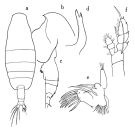 issued from : O. Tanaka in Publs Seto Mar. Biol. Lab., 1964, XII (1). [p.56, Fig.200]; Female: a, habitus (dorsal); b, forehead (left lateral side); c, last thoracic segment and urosome (left lateral side); d, biting blade of Md; e, Mx1; f, P5. Nota: The urosome segments and furca are in the proportional lengths as 48:12:17:23 = 100.
|
 issued from : J.M. Bradford-Grieve in The Marine Fauna of New Zealand: Pelagic Calanoid Copepoda. National Institute of Water and Atmospheric Research (NIWA). NIWA Biodiversity Memoir, 111, 1999. [p.57, Fig.28]. Female: A, habitus (dorsal); B, idem (lateral left side); C, Md (mandibular palp); D, Mx1; E, P1; F, P5. Nota: The specimen has 11 spines on inner lobe 1 of Mx1.
|
 issued from : O. Tanaka & M. Omori in Publs Seto Mar. Biol. Lab., 1974, XXI (3/4). [p.244, Fig.23]. Female: a, Md; b, distal part of Mx1; c, Mx2. Mx1 bears 9 setae on the outer lobe, 2 on the exopod, 2 on the 2nd basal segment, 2 on the 3rd inner lobe, 1 on the 2nd inner lobe, 11 on the 1st inner lobe. The 2nd basal segment, exopod and endopod of Md, and the exopod of Mx1 have numerous fine ornementation.
|
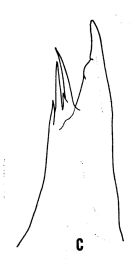 issued from : O. Tanaka & M. Omori in Publs Seto Mar. Biol. Lab., 1974, XXI (3/4). [p.199, Fig.2,c]. Female: c, mandibular teeth.
|
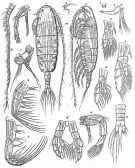 Issued from : G.O. Sars in Résult. Camp. Scient. Prince Albert I, 69, pls.1-127 (1924). [Pl.LXXXI, figs.1-16]. Female: 1, habitus (dorsal); 2, idem (lateral left side); 3, forehead (lateral); 4, rostrum; 5, A2; 6, Md; 7, Mx1; 8, Mx2; 9, Mxp; 10, P1; 11, P3; 12, P5. Male: 13, left A1; 14, A2; 15, P5; 16, urosome (dorsal).
|
 issued from : R.B.S. Sewell in The John Murray Expedition, 1933-34, Scientific Reports, VIII (1), 1947. [p.218, Fig.58]. Female (from Arabian Sea): A, A2; B, Md; C, Mx1; D, Mx2; E, P1; F, P5. Nota: The proportional lengths of the anterior and posterior region as 75 to 25.
The proportional lengths of the various segments of the body (cephalon to caudal rami) as 374:134:80:77:91:107:36:52:49 = 1000. Rostrum represented by a pair of short, stout spinous prominence. A1 25-segmented, overreaches the caudal rami by about the last 5 segments. Exopod of A2 with 7 segments (the two distal fused, though a trace of the line of separation can be seen). n Md the two rami of the palp are approximately equal length; the endopod bears 6 setae distally; the proximal segments of both endopod and exopod, as well as the 2nd basal segment, are ornamented with numerous small fine bosses. In Mx1 the biting lobe is well developed and bears 9 elongate spines, of which the anterior 7 are armed with small spinules, gradually changing to small \"buttons\" distally, and 2 other delicate, smaller setae; the 2nd inner lobe bears 1 stout seta and the inner 3rd posseses a pair of sub-equal setae; the 2nd basal segment with 1 seta; endopod absent; the exopod, like the proximal segments of the exopod and endopod of the A2, is ornamented with numerous small bosses and bears distally 2 setae; the outer lobe bears 9 setae, of which the three proximal are small and delicate, the 4th is of moderate thickness, the 5th is slender, the 6th is long and stout, and the distal three are like the 4th. In Mx2 the 1 st lobe bears 3 setae and a small pointed papilla; the others lobes bear respectively 1, 2, 3, 2, 3 setae, the distal setae are fringed with small and delicate \"buttons\". In Mxp the distal setae are provided with small delicate \"buttons\".
|
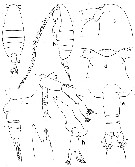 issued from : T. Park in Biology of the Antarctic Seas, XXII. Antarct. Res. Ser., Washington, 58. [p.45, Fig.31]. Female: a-b, habitus (dorsal and lateral, respectively); c, forehead (lateral and ventral, respectively); e-f, urosome (dorsal and lateral, respectively); g, A2; h, Md; i, Md (biting edge).
|
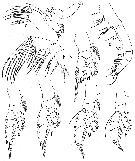 issued from : T. Park in Biology of the Antarctic Seas, XXII. Antarct. Res. Ser., Washington, 58. [p.46, Fig.32]. Female: a, Mx1; b, Mx2; c, Mxp; d-h, P1 to P5 (anterior views).
|
 issued from : C.O. Esterly in Univ. Calif. Publs Zool., 1906, 3 (5). [Pl.9, Fig.19]. As Augaptilus rostratus. Female (from San Diego, California): 19, forehead (lateral).:
|
 issued from : C.O. Esterly in Univ. Calif. Publs Zool., 1906, 3 (5). [Pl.11, Fig.42]. As Augaptilus rostratus. Female: 42, urosome (lateral).
|
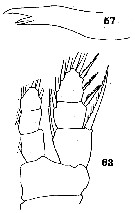 issued from : C.O. Esterly in Univ. Calif. Publs Zool., 1906, 3 (5). [Pl.12, Figs.57, 63]. As Augaptilus rostratus. Female: 57, Md (mandibular blade); 63, P1
|
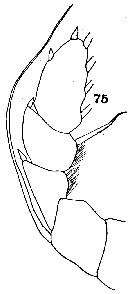 issued from : C.O. Esterly in Univ. Calif. Publs Zool., 1906, 3 (5). [Pl.13, Fig.75]. As Augaptilus rostratus. Female : 75, exopod of P5.
|
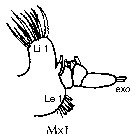 issued from : J.M. Bradford-Grieve, E.L. Markhaseva & C.E.F. Rocha & B. Abiahy in South Atlantic Zooplankton, Edit. D. Boltovskoy. 1999. Vol.2. Copepoda. [p.1039, Fig. 7.258]. Female: Mx1. Nota: Exo of Mx1 with 5 setae; outer lobe 1 with 7 setae.
| | | | | Ref. compl.: | | | Sewell, 1948 (p.330, 505, 522, 531, 533, 547); C.B. Wilson, 1950 (p.206); Grice, 1963 a (p.496); De Decker & Mombeck, 1964 (p.12); Park, 1970 (p.478); Itoh, 1970 (tab.1); Roe, 1972 (p.277, tabl.1, tabl.2); Deevey & Brooks, 1977 (p.156, tab.2, Station "S"); Vives, 1982 (p.294); Lozano Soldevilla & al., 1988 (p.60); Heinrich, 1990 (p.18); Razouls & al., 2000 (p.343, Appendix); Fernandes, 2008 (p.465, Tabl.2); Galbraith, 2009 (pers. comm.); Park & Ferrari, 2009 (p.143, Table 5, Appendix 1, biogeography); Matsuura & al., 2010 (p.2098, Table 2, 3, fig.8); Medellin-Mora & Navas S., 2010 (p.265, Tab. 2) | | | | NZ: | 16 | | |
|
Carte de distribution de Euaugaptilus oblongus par zones géographiques
|
| | | | | | | | | | Loc: | | | Antarct. (Indian), sub-Antarct. (Indian), South Africa (E), off N Ste Hélène Is., G. of Guinea, off Mauritania, Canary Is., off Madeira, Azores, Bay of Biscay, Caribbean Colombia, Caribbean Sea, off Bermuda (Station "S"), Sargasso Sea, Islande S, Strait of Denmark, Arabian Sea, Indian, Laccadive Is., Bay of Bengal, Celebes and Sulu Seas, Japan (Izu), Kuril-Kamtchatka, Vancouver Is., California, Pacif. (tropical), SW Galapagos, Pacif. (SE tropical), NE Easter Is., off Peru, New Zealand (SW North Island, SE South Island) | | | | N: | 32 | | | | Lg.: | | | (1) F: 7,4; (10) F: 4,65; (11) F: 6,15; (16) F: 6,9-5,4; M: 5,7-5,4; (17) F: 6,8; (22) F: 6,8; (48) F: 7,25-6,16; (49’) F: 5,7; (68) F: 6,33-5,97; (69) F: 6,06; (199) F: 5,93-5,92; (909) F: 6,1-6,3; {F: 4,65-7,40; M: 5,40-5,70} | | | | Rem.: | méso-bathypélagique.
Sampling depth (Antarct., sub-Antarct.): 0-1200 m.
Malgré la grande différence des tailles, Grice & Hulsemann (1967) ne doutent pas de la synonymie entre cette espèce et Augaptilus subfiligerus.
Pour Matthews (1972) et Park (1993), la forme signalée par Tanaka & Omori (1967) comme E. oblongus n’est pas synonyme de E. rectus comme l’affirment Tanaka & Omori (1974, p.252).
Voir aussi les remarques en anglais | | | Dernière mise à jour : 11/07/2022 | |
|
|
 Toute utilisation de ce site pour une publication sera mentionnée avec la référence suivante : Toute utilisation de ce site pour une publication sera mentionnée avec la référence suivante :
Razouls C., Desreumaux N., Kouwenberg J. et de Bovée F., 2005-2025. - Biodiversité des Copépodes planctoniques marins (morphologie, répartition géographique et données biologiques). Sorbonne Université, CNRS. Disponible sur http://copepodes.obs-banyuls.fr [Accédé le 01 janvier 2026] © copyright 2005-2025 Sorbonne Université, CNRS
|
|
 |
 |















